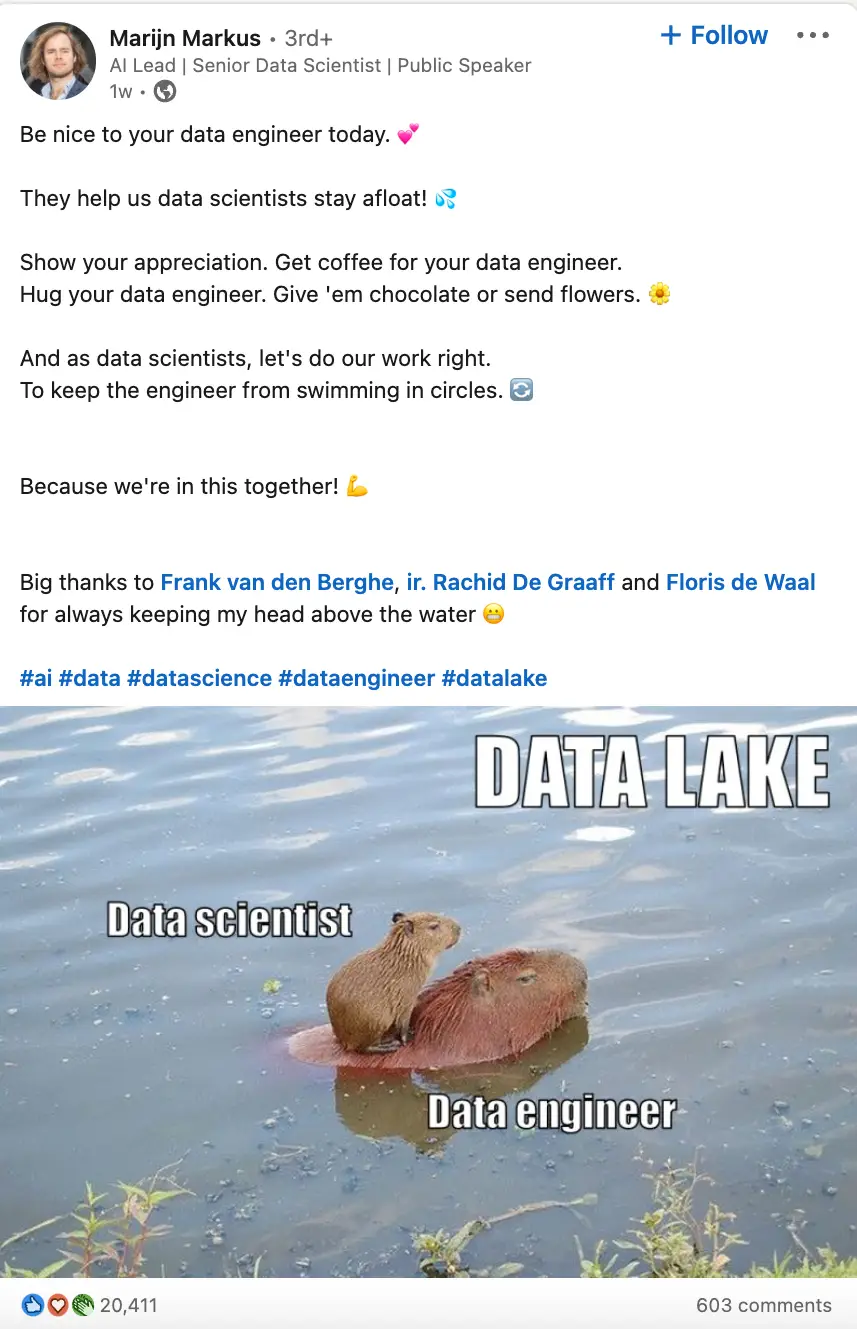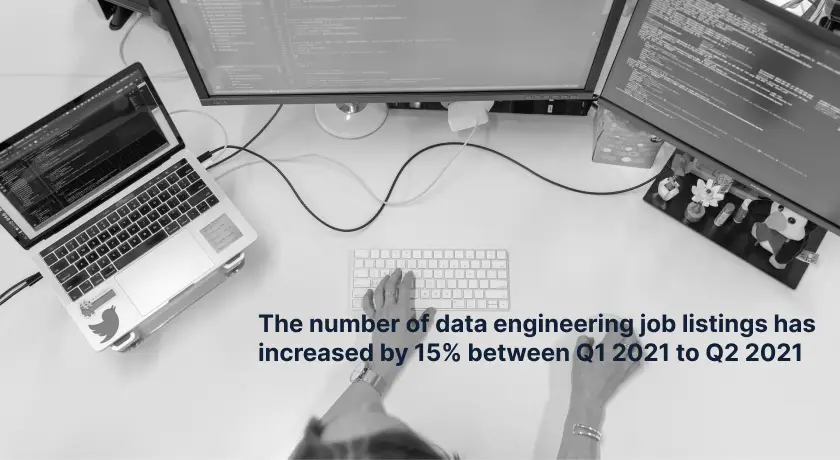Data engineer roles have gained significant popularity in recent years. This study by Dice shows that the number of data engineering job listings has increased by 15% between Q1 2021 to Q2 2021, up 50% from 2019.
In addition to being an in-demand role, working as a data engineer can allow you to solve problems, experiment with large datasets, and understand patterns in our world. Students and professionals looking for a switch to a technology role should consider a career in data engineering.
To help you understand the requirements of a data engineer, we’ve compiled the roles and responsibilities of data engineers, the tools they use, and what you need to get started as a data engineer.
- What is a Data Engineer?
- Data Engineers vs Data Scientists vs Data Architects: What are the differences?
- What Tools do Data Engineers Use?
- What Skills do I Need to Learn to be a Data Engineer?
- Should I Purse a Career in Data Engineering?
What is a Data Engineer: An Overview of the Responsibilities
Data engineers are responsible for designing, maintaining, and optimizing data infrastructure for data collection, management, transformation, and access. They are in charge of creating pipelines that convert raw data into usable formats for data scientists and other data consumers to utilize. The data engineer role evolved to handle the core data aspects of software engineering and data science; they use software engineering principles to develop algorithms that automate the data flow process. They also collaborate with data scientists to build machine learning and analytics infrastructure from testing to deployment.
Data engineers help organizations structure and access their data with the speed and scalability they need and provide the infrastructure to enable teams to deliver great insights and analytics from that data. Kevin Wylie, a data engineer with Netflix, says his work is about making the lives of data consumers easier and enabling these consumers to be more impactful.
Most times, the format/structure optimal to store data for an application is rarely optimal for data science/reporting/analytics. For example, your application may need to be able to serve one million concurrent requests for individual records. But your data science team might need to access billions of records per time. Both scenarios will require different approaches to solve their problems, and this is where data engineers can help.
The primary responsibility of a data engineer is ensuring that data is readily available, secure, and accessible to stakeholders when they need it. Data engineering responsibilities can be grouped into two main categories:
Data structure and management
Data engineers are responsible for implementing and maintaining the underlying infrastructure and architecture for data generation, storage, and processing. Their responsibilities include:
- Building and maintaining data infrastructure for optimal extraction, transformation, and loading of data from a wide variety of sources such as Amazon Web Services (AWS) and Google Cloud big data platforms.
- Ensuring data accessibility at all times and implementing company data policies with respect to data privacy and confidentiality.
- Improving data systems reliability, speed, and performance.
- Creating optimal data warehouses, pipelines, and reporting systems to solve business problems.
Data analysis and insight
Data engineers play an important role in building platforms that enable data consumers to analyze and gain insights from data. They are responsible for:
- Cleaning and wrangling data from primary and secondary sources into formats that can be easily utilized by data scientists and other data consumers.
- Developing data tools and APIs for data analysis.
- Deploying and monitoring machine learning algorithms and statistical methods in production environments.
- Collaborating with engineering teams, data scientists, and other stakeholders to understand how data can be leveraged to meet business needs.
Although every organization has slightly different requirements, data engineering job listings from top tech company’s career sites like Netflix and Google and articles from job sites such as Indeed can provide more information on what data engineers are commonly responsible for in an organization.
Data Engineers vs. Data Scientists vs. Data Architects: What are the Differences?

These roles vary significantly from company to company and often overlap since their work usually revolves around the same key component: data. Larger companies tend to have separate departments for these roles, and in smaller companies, it’s not uncommon to have one person acting as all three.
This table gives a brief overview of the differences between the three roles.
| Data Architect | Data Engineer | Data Scientist |
|---|---|---|
| Data architects plan and design the framework the data engineers build. They create the organization’s logical and physical data assets, as well as the data management resources, and they set data policies based on company requirements. | Data engineers are responsible for gathering, collecting, and processing data. They also build systems, algorithms, and APIs to expose datasets to data consumers. | Data scientists are responsible for performing statistical analysis using machine learning and artificial intelligence on collated data in order to gain insight and form new hypotheses. |
Unless a company has a large data/engineering team, it’s unlikely to have all three of these roles and will likely employ some combination of the above based on engineering, data, and business needs. Read more: For a deeper dive into how data architects and data engineers differ in responsibilities, skill sets, and career paths, see our comparison: Data Architect vs. Data Engineer.
What Tools Do Data Engineers Use?
There are no one-size-fits-all tools data engineers use. Instead, each organization leverages tools based on business needs. However, below are some of the popular tools data engineers use. You don’t necessarily have to gain mastery of all the tools here, but we recommend you learn the fundamentals of each core tool.
Databases
In our fast-paced world where tools and technologies are constantly evolving, SQL remains central to it all and is a foundational tool for data engineers. SQL is the standard programming language for creating and managing relational database systems (a collection of tables that consist of rows and columns).
NoSQL databases are non-tabular and can take the form of a graph or a document, depending on their data model. Popular SQL databases include MYSQL, PostgreSQL, and Oracle. MongoDB, Cassandra, and Redis are examples of popular NoSQL databases.
Data processing
Today’s businesses recognize the importance of processing data in real-time to enhance business decisions. As a result, data engineers are in charge of building real-time data streaming and data processing pipelines. Apache Spark is an analytics engine used for real-time stream processing; Apache Kafka is a popular tool for building streaming pipelines and is used by more than 80% of fortune 500 companies.
For example, Netflix uses Kafka to process over 500 billion events per day, ranging from user viewing activities to error logs.
Programming languages
Data engineers are typically fluent in at least one programming language to create software solutions to data challenges. Python is regarded as the most popular and widely used programming language in the data engineering community. It’s easy to learn and features a simple syntax and an abundance of third-party libraries geared toward data needs.
Data migration and integration
As more companies leverage cloud-based computing to meet business demands, migrating mission-critical applications can introduce several challenges of which migrating the underlying database is often the most difficult. Data migration and integration refer to the processes involved in moving data from one system or systems to another without compromising its integrity. Data integration specifically is the process of consolidating data from various sources and combining it in a meaningful and valuable way.
Striim is a popular real-time data integration platform used by data engineers for both data integration and migration; it provides modern, reliable data integration and migration across the public and private cloud.
Distributed systems
Because of the massive amount of data in circulation today, a single machine/system cannot meet data processing and storage requirements. Distributed systems are systems that work together to achieve a common goal but appear to the end-user as a single system.
Hadoop is a popular data engineering framework for storing and computing large amounts of data using a network of computers.
Data science and machine learning
Data engineers need a basic understanding of popular data science tools because it enables them better to understand data scientists and other data consumers’ needs. PyTorch is an open-source machine learning library used for deep learning applications using GPUs and CPUs. TensorFlow is a free, open-source machine learning platform that provides tools for teams to create and deploy machine learning-powered applications.
What Skills Do I Need to Learn to be a Data Engineer?
Data engineering is a developing field that bisects software engineering and data science. While there are no defined steps to becoming a data engineer, that doesn’t mean you can’t do it.
Here are some of the necessary skills and knowledge you need to become a successful data engineer.
- Understand databases (SQL and NoSQL): An essential skill for data engineers is learning how databases work and how to write queries to manipulate and retrieve data. This free database systems course by freeCodeCamp and Cornell University is an excellent resource to learn how database systems work.
- Understand data processing techniques and tools: LinkedIn Learning provides fantastic resources to learn Apache Kafka – a popular tool for data processing.
- Know a programming language: Knowing how to program is a must-have skill for data engineers. Programming languages such as Python and Scala are popular with data engineers. The complete Python Bootcamp on Udemy is a popular resource for getting started with Python.
- Understand how distributed systems work: Designing Data-Intensive Applications is a great resource to understand the fundamental challenges companies face when designing large data applications.
- Learn about cloud computing: With more companies relying on cloud providers for data infrastructure needs, learning how to design and engineer data solutions using popular cloud providers such as Amazon Web Services, Google Cloud, and Azure will help you stand out as a data engineer. Online courses, official tutorials, and certifications from cloud providers (like this one from Google Cloud ) are excellent ways to learn cloud computing.
Many data engineers teach themselves skills through free and low-cost online learning programs. The Data Engineering Career Learning Path by Coursera and the Learn Data Engineering Academy provides practical resources to get you started. If you prefer a more degree-oriented approach, Udacity offers a specialized track dedicated to data engineering.
Should I Pursue a Career in Data Engineering?
Research from Domo estimates that humans generate about 2.5 quintillion bytes of data per day through social media, video sharing, and other means of communication. Furthermore, the World Economic Forum predicts that by 2025, the world will generate 463 exabytes of data per day, the equivalent of 212,765,957 DVDs per day. With the copious amount of data generated, there will be an increase in the demand for data engineers to manage it.
If you love experimenting with data, using it to discover patterns in technology or enjoy building systems that organize and process data to help companies make data-driven decisions, you might consider a career in data engineering. Further, data engineering is a lucrative field, with a median base salary of $102,472. While data engineering can be difficult and complex, and you may need to learn new skills and technology, it is also a rewarding career in a growing field.
























